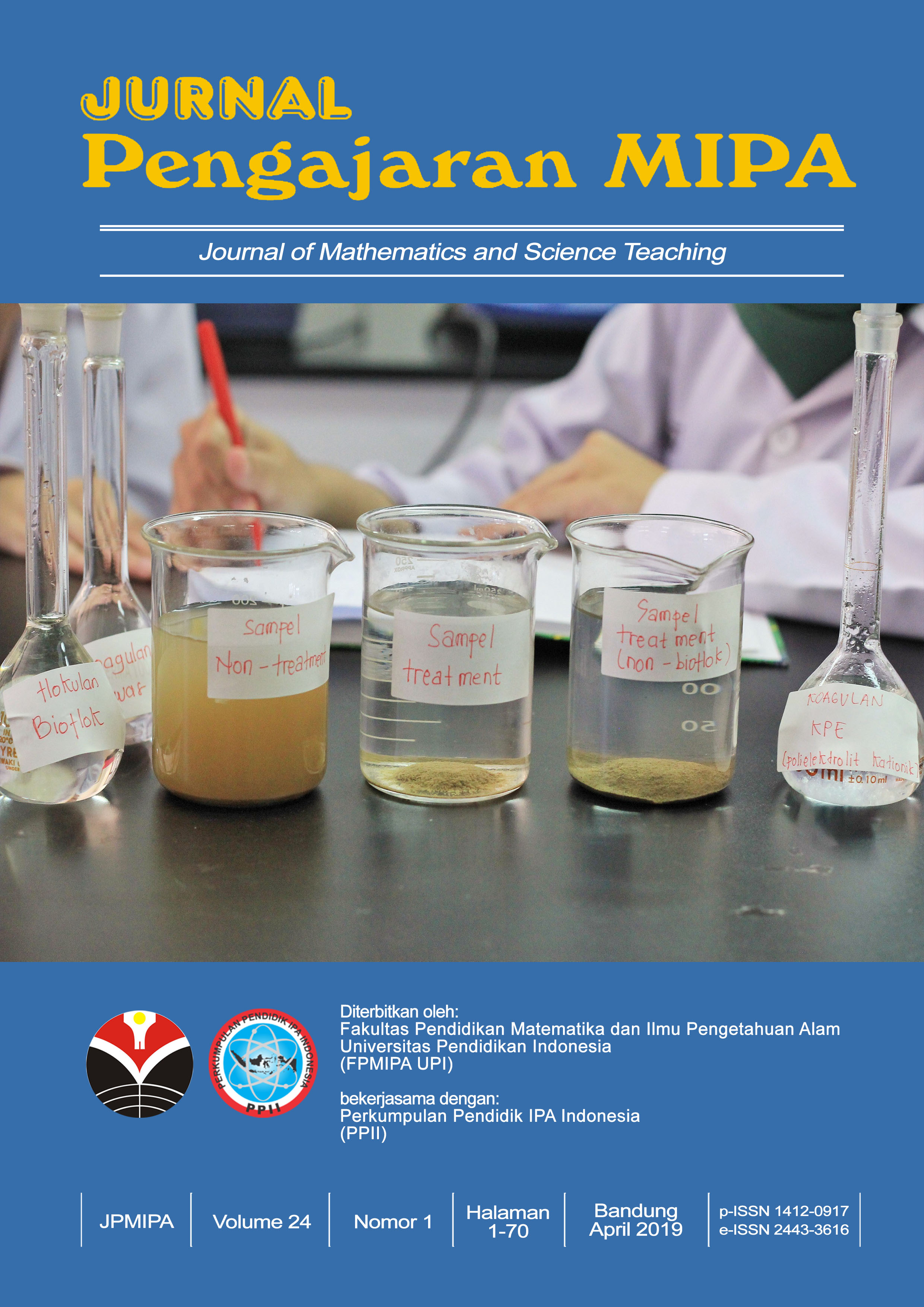PENGEMBANGAN MODEL PEMBELAJARAN BERBASIS TEORI VAN HIELE UNTUK MENINGKATKAN KEMAMPUAN GEOMETRI SISWA SMP DI KOTA BANDA ACEH
Abstract
ABSTRAK
Penguasaan siswa terhadap materi geometri hingga saat ini masih rendah sehingga masih banyak siswa yang mengalami kesulitan dalam belajar geometri. Salah satu faktor penyebab rendahnya penguasaan siswa adalah faktor pembelajaran. Pembelajaran geometri secara konvensional tidak mempertimbangkan perbedaan kemampuan siswa dalam geometri. Oleh karena itu, untuk memandu pengajaran geometri, perlu dikembangkan sebuah model pembelajaran berbasis teori van Hiele yang dapat melayani kebutuhan semua siswa yang bervariasi dalam kemampuan geometrinya. Pengembangan model pembelajaran pada penelitian ini mengacu pada pada model umum masalah pendidikan dari Plomp, yang meliputi: fase investigasi awal, fase desain, fase realisasi, fase tes, evaluasi dan revisi, dan fase implementasi. Pada penelitian ini, pengembangan hanya sampai pada fase keempat. Berdasarkan hasil pengembangan, diperoleh model pembelajaran berbasis teori van Hiele beserta perangkatnya yang memenuhi kriteria valid, praktis, dan, efektif, sehingga model ini merupakan model pembelajaran yang memiliki kualitas baik. Sintak model pembelajaran ini meliputi: orientasi pembelajaran, diskusi kelompok, diskusi kelas, integrasi, dan evaluasi.
ABSTRACT
Nowadays, students’ proficiency in geometry is still not sufficient; therefore, many students experience difficulties in learning geometry. One of factors that contribute to the students’ low proficiency is learning factor. A conventional learning of geometry does not take the differences of students’ ability in geometry into account. Thus, to conduct geometry lessons, it is essential to develop a van Hiele-based learning model that can serve different ranges of students’ need for their geometry competence. The development of learning model in this research refers to the general model of education matters by Plomp, which include several phases: initial investigation, designing, realization, testing, evaluation and revision, and implementation. In this research, the development was only until the fourth phase. According to the results, a valid, practical and effective van Hielebased learning model and its instruments has been developed; therefore, this model is considered as having a good quality. The steps of the learning model consist of: learning orientation, group discussion, integration, and evaluation.
Keywords
Full Text:
PDFReferences
Arends, R.I. 1997. Classroom Instruction and Management. Boston: McGraw Hill.
Bell, F.H. 1978. Teaching and Learning Mathematics (In Secondary Schools). Dubuque: Wm C. Brown Company.
Bennet Dan. Exporing Geometry. USA: Key College Publishing, 2007.
Burger, W.F. and Shaughnessy, J.M. 1986b. Characterizing the van Hiele Levels of Development in Geometry. Journal for Research in Mathematics Education, 17(1): 31-48. Reston: NCTM.
Clements, D.H., Swaminathan, S., Hannibal, M.A.Z. dan Sarana, J. 1999. Young Children's Concepts of Shape. Journal for Research in Mathematics Education, 30(2): 192-212. Reston: NCTM.
Crowley, M.L. 1987. The van Hiele Model of the Development of Geometric Thought. Dalam Lindqueist, M.M. and Shulte, A.P. (Eds.). Learning and Teaching Geometry K-12 (hlm. 1-16). Reston: NCTM.
D'Augustine, C. and Smith, C.W. 1992. Teaching Elementary School Mathematics. Boston: Harpe Collins Publisher Inc.
Fuys, D., Geddes, D., and Tischer, R. 1988. The van Hiele Model of Thingking in Geometry Among Adolescents. Journal for Research in Mathematics Education. Monograph no. 3. Reston: NCTM.
Herberg, Theodore, and Orleans, Joseph B. A New Geometry for Secondary schools. USA: D. C. Heath and Company, 2008.
Hudojo, H. 1988. Mengajar Belajar Matematika. Jakarta: P2LPTK Dirjen Dikti Depdikbud.
Joyce, B. & Weil, M. 1996. Models of Teaching (5th ed.). Boston: Allyn & Bacon.
Joyce, B., Weil, M., with Shower, B. 1992. Models of Teaching (4th ed.). Boston: Allyn & Bacon.
Reynolds, Barbara E; and Fenton William E. College Geometry, Using The Geometre’s Skechpad. USA: Key College Publishing, 2006.
Steffe, L.P. 1996. Theories of Mathematical Learning. New York: Lawrence Erlbaum. Associates Publisher.
Suparno, P. 1997. Filsafat Konstruktivisme dalam Pendidikan. Yogyakarta: Kanisius.
Tadao, N. 2000. The Constructive Approach in Mathematics Education. Japan Society of Mathemaical Education (JSME), Mathematics Education in Japan (hlm. 88-90). Tokyo: JSME.
van de Walle, J.A. 1994. Elementary School Mathematics. New York: Longman.
van Hiele, P.M. 1999. Developing Geometric Thinking through Activities That Begin with Play. Teaching Children Mathematics, 5(6): 310-316. Reston: NCTM.
Wells, David W; Dalton, Leroy C; and Brunner, Vincent F. Using Geometry. USA: Laidlaw Brothers, Publishers., 1998.
Woolfolk, A.E. 1998. Educational Psychology (7"' ed.). Boston: Allyn & Bacon.
DOI: https://doi.org/10.18269/jpmipa.v17i2.36072
Refbacks
- There are currently no refbacks.
Copyright (c) 2021 Jurnal Pengajaran MIPA

This work is licensed under a Creative Commons Attribution-ShareAlike 4.0 International License.
JPMIPA http://ejournal.upi.edu/index.php/jpmipa/index is licensed under a Creative Commons Attribution-ShareAlike 4.0 International License
Jurnal Pengajaran Matematika dan Ilmu Pengetahuan Alam (JPMIPA) or Journal of Mathematics and Science Teaching
All rights reserverd. pISSN 1412-0917 eISSN 2443-3616
Copyright © Faculty of Mathematics and Science Education (FPMIPA) Universitas Pendidikan Indonesia (UPI)
View JPMIPA Stats









